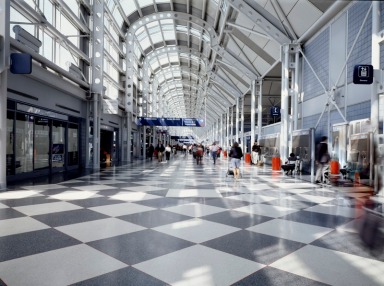 Think back for a moment to what aviation was like 60 years ago. The DC-3 was a common sight and the Boeing 707 was brand new. Passengers could be accompanied by their families all the way to the gates. TWA, Eastern and Piedmont offered flights at my airport. Things sure have changed a lot since then! Well, except for the terminal. It has had several additions and face-lifts over the years, but at its core it is the same building in the same location as it was in 1958.
Think back for a moment to what aviation was like 60 years ago. The DC-3 was a common sight and the Boeing 707 was brand new. Passengers could be accompanied by their families all the way to the gates. TWA, Eastern and Piedmont offered flights at my airport. Things sure have changed a lot since then! Well, except for the terminal. It has had several additions and face-lifts over the years, but at its core it is the same building in the same location as it was in 1958.

O’Hare International Airport also has a big terminal construction project planned. (Photo by Carol M. Highsmith [Public domain], via Wikimedia Commons)

Salt Lake City International Airport is in the middle of a large expansion project. Estimated cost: $3 Billion (Photo by GoMan195531 at English Wikipedia via Wikimedia Commons)
After 60 years, the functional life of our terminal is starting to wind down. We went through a modernization program recently that will extend our ability to use the building another 15 years or so. However, the time is coming when a new building will be needed. But… how do we know when that time is? As it turns out, the answer is rather complicated.
The first, and perhaps most obvious, factor is the number of passengers using the terminal. We know the maximum number that the current facility can reasonably handle. When we reach a certain point in passenger growth we’ll need to start construction so that the new building is ready when we hit max capacity. Another thing to consider involves infrastructure. When key items like boilers, furnaces and AC units begin to wear out, it will probably make more sense to start construction on a new terminal than to spend millions of dollars putting new equipment into an old building. There are other factors as well, but these two are probably the biggest. If we keep going at our current pace, we expect to hit one of these thresholds in the next 8-10 years.

Indianapolis’ new terminal opened in 2008. I dig the trippy lighting! (photo by By utahwildflowers via Wikimedia Commons)
Even though construction won’t start for a while that doesn’t mean we can just sit back and relax. Nope – there are a whole lot of things we’ve been working on in the meantime. First off we had to figure out where the new terminal should go, as well as the parking garages, lots, rental car facilities, etc. Then we had to work on all the studies, evaluations, surveys, environmental impact reviews, wetland assessments, etc. that are routinely required as part of any construction project. Then once all of that has been worked out, the basic infrastructure must to be put into place so that when we’re ready to start building, we have what we need. In our case that means putting in all the utility lines, as well as relocating some of the big RTR antennas.
Another thing on the to-do list is figure out how to pay for it all. The full project is slated to cost over a billion dollars. Ouch! Most airports use a combination of methods to finance this type of project including borrowing money, obtaining grants and using Passenger Facility Charge (PFC) funds.

Concourses B and C at Philadelphia International Airport were also built in the late 50s. (Photo by David Broad via Wikimedia Commons.)
Not familiar with PFCs? Check your next airline ticket. Every time you get onto an airplane you’ll see a charge of $4.50 (capped at $18/trip). The airlines are required to charge these fees and then remit them to the airports. I love recording the PFC charges because they come from airlines all over the world. We routinely receive remittances from Japan Airlines, Air France, Luftansa and Qantas. No, none of those airlines fly into my airport. However, if you buy a ticket to Paris via Air France, then Air France will charge you the PFC and remit those funds to us, even though you’ll actually fly out of my airport on one of their partner airlines (or one of their partner’s regional carriers). The FAA has pretty strict rules about how PFCs can be used. Airports can only use them for very specific things like enhancing security, reducing noise or increasing capacity. FAA approval is required in advance – and the airlines are allowed to give their input as well.

Wouldn’t be a post from me if I didn’t include a pic of the latest cool airplane to fly in!
One thing my airport won’t use to finance the new terminal is local taxes. Since we aren’t owned by the city or county but instead function as an independent agency, we don’t use county or city taxes for construction projects or for our daily operations either.
So, what DOES the airport of the future look like? Well I’ve heard we are going for a modular design that will allow us to start with what we need, and leave room for us to easily add/adapt as passenger and airline needs change. The proposed design itself is… interesting. A lot can change in 10 years, so what the terminal will actually look like remains to be seen. But based on the most recent conceptualization let’s just say that I think the Jetsons would feel right at home.

I’m not saying Hanna Barbera designed the look for the new terminal… but they totally could have!